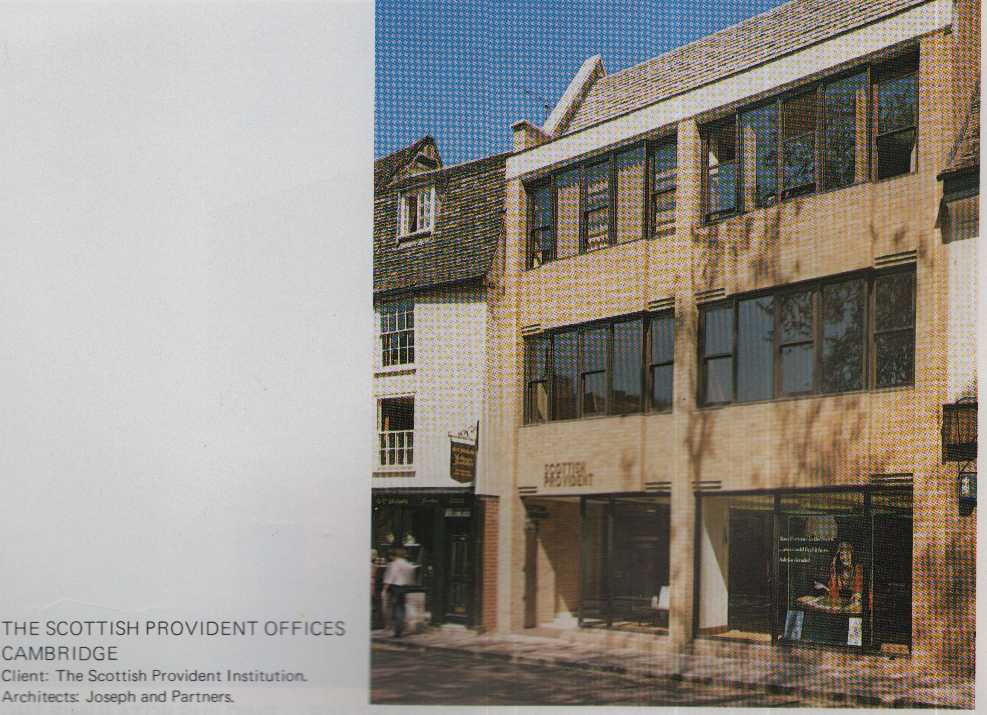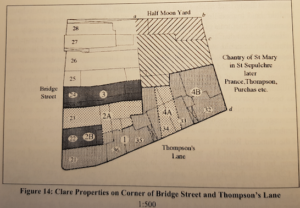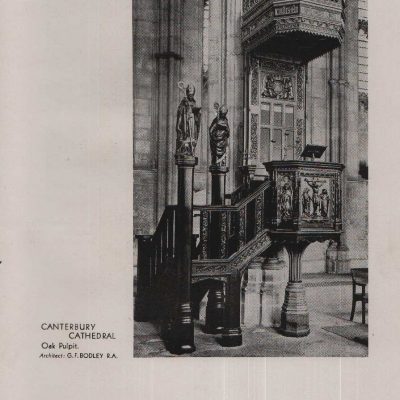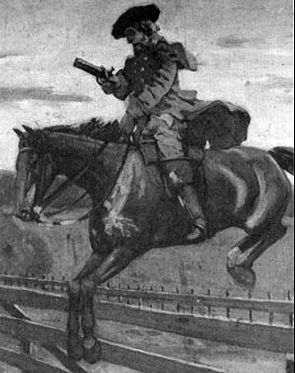Search by topic
- archaeology
- architecture
- bricklayer
- Building of Local Interest
- carpenter
- church
- crime
- dressmaker
- fire
- general labourer
- Great Eastern Railway
- listed building
- medieval
- oral history
- Public House
- Rattee & Kett
- Roman
- scholar
- school
- Then and Now
- tudor
- women
- work
- world war one
- world war two
Search by text

27 Bridge Street, Scottish Provident/Wildwood, the Griffin, the Crow
History of 27 Bridge Street
Information from T E Faber, An Intimate History of St Clement’s Parish, 2006.
This site is the only one in the parish to have been owned by Trinity Hall.
1295 John Butt (mayor frequently between 1277 and 1295)
The landlocked garden plot behind nos. 27 and 28 was released in 1461 as part of a larger area which extended further south, by Richard Everard of Crowland and Robert Garlond of Cambridge, to draper William Dak amongst others. There is strong evidence that Everard and Garlond also held no.27 as well.
Earliest mention of the Griffin is in document from 1483, 1491 and 1493. In 1483 Edward/Edmund Damay pays 1d for ‘le Gryffin’.
c.1510: Walter Hewke bought Griffin from Councillor Hankyn Aunsell for £100. He installed Walter Lombe as his tenant and entertained the Fellows of Trinity Hall to dinner there; at the same time he bought the two ‘houses against the Griffin’.
1518 death of Walter Hewke, master of Trinity Hall. His will contain the instructions to establish a chaplain/fellow at the college to be called ‘Dr Hewkes preest.’ This was to be funded by his bequest of ‘all my hole Inne called the Gryffin lyinge in Bryggestrete [in St Clement’s] with all the appurtenances and landes belonging thereto‘, plus two tenements ‘ with their two hole gardyns […] right on and ayene the foresaid Inne‘, plus two other tenements ‘by the Dolfyn in Allhallows’.
1527 – 1538 12d rent paid to Trinity Hall
1538 – 1541 Trinity Hall must have sold the property to Thomas Farrer. Thomas died in 1540; he owned the Griffin and leased the Bull on the other side of the road. He left both inns to his wife for life then to his son William.
after 1540: occupant was Bradburne
c. 1554: Griffin bought by Alderman John Lyne. Quit rent paid by John, his son William I and grandson William II, or their tenants, until 1617. (Lyne family also owned no.28)
1590 no. 27 sold by Lyne family to Lambert Dampes. Business and name of the Griffin at no. 27 transferred to no.28.
1593 no. 27 left by Dampes to the Mayor and Bailiffs of the town to fund a charitable distribution of sea coals to the poor. Described in his will as a free house in St Clement’s ‘wherin Thomas Birch now dwelleth.’
1604 town let property to Eward Male rent £4. Leased at that rent until 1783.
1627-59 Thomas Coward named as occupant of a ‘capital messuage commonly called […] the Crow’ in town leases dated 1638 and 1649. The name ‘Crow’ transferred to no.29 because no.27 ceased to be an alehouse after Thomas Coward’s death or retirement in c. 1659.
1851 occupied by an upholsterer
1861
Robert Hills, 73, cabinet maker, b Cambridge
Catherine, 73, b Suffolk
William R, 44, upholsterer, b Cambridge
Caroline, 42, b Cambridge
Maryann E Goshawk, grand daughter, 17, b Cambridge
Caroline Goshawk, grand daughter, 11, b Cambridge
1871 the Spotted leopard with Goss’s Passage or Spotted Leopard Passage beside it.
Henry J P Goss, victualler, 37, b Lancaster
Eliza Goss, 47, b Bottisham
Charlotte R Chapman, servant, 14, b Cambridge
1881
Mary Ann Newman, beer house keeper, widow, 60, b Kingston
Emily Newman, daughter, cook, 18, b St. Ives
1895 vacant building plot
1906 A MacIntosh and Sons, ironmongers
1960 Skeel’s bicycle business
1962
Victoria Wine Com
John Lucas
The current building, occupied in 2017 by the Wildwood restaurant, was formerly the offices of The Scottish Provident. The building was constructed by Rattee and Kett circa 1978.
Contribute
Do you have any information about the people or places in this article? If so, then please let us know using the Contact page or by emailing capturingcambridge@
License
 This work is licensed under a Creative Commons Attribution-NonCommercial-ShareAlike 4.0 International License.
This work is licensed under a Creative Commons Attribution-NonCommercial-ShareAlike 4.0 International License.













